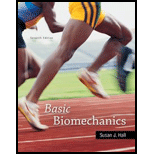
Concept explainers
a)
To determine: The torque produced at
a)
Answer to Problem 9AP
The torque created at
Explanation of Solution
Calculation:
Write an expression to find the torque at
Here,
Substitute 100 N for
Therefore, the torque created at
Therefore, the torque created at
b)
To determine: The torque produced at
b)
Answer to Problem 9AP
The torque created at
Explanation of Solution
Calculation:
Write an expression to find the torque at
Here,
Substitute 100 N for
Therefore, the torque created at
Therefore, the torque created at
c)
To determine: The torque produced at
c)
Answer to Problem 9AP
The torque created at
Explanation of Solution
Calculation:
Write an expression to find the torque at
Here,
Substitute 100 N for
Therefore, the torque created at
Therefore, the torque created at
d)
To determine: The torque produced at
d)
Answer to Problem 9AP
The torque created at
Explanation of Solution
Calculation:
Write an expression to find the torque at
Here,
Substitute 100 N for
Therefore, the torque created at
Therefore, the torque created at
e)
To determine: The torque produced at
e)
Answer to Problem 9AP
The torque created at
Explanation of Solution
Calculation:
Write an expression to find the torque at
Here,
Substitute 100 N for
Therefore, the torque created at
Therefore, the torque created at
Want to see more full solutions like this?
- Explain why (a) calcium ions and (b) ACh are vital for muscle contraction.arrow_forwardFigure 38.37 Which of the following statements about muscle contraction is true? The power stroke occurs when ATP is hydrolyzed to ADP and phosphate. The power stroke occurs when ADP and phosphate dissociate from the myosin head. The power stroke occurs when ADP and phosphate dissociate from the actin active site. The power stroke occurs when Ca2+ binds the calcium head.arrow_forwardCheetahs and human sprinters tend to have a high proportion of ________fibers in their leg muscles. a. white b. fast red c. slow redarrow_forward
- You are training athletes for the 100-meter dash. They need muscles specialized for speed and strength, not endurance. What muscle characteristics would your training regimen aim to develop? How would you alter it to train a long-distance swimmer?arrow_forwardWhat is a motor unit? Why does a rapid series of muscle twitches yield a stronger overall contraction than a single twitch?arrow_forward
 Human Physiology: From Cells to Systems (MindTap ...BiologyISBN:9781285866932Author:Lauralee SherwoodPublisher:Cengage Learning
Human Physiology: From Cells to Systems (MindTap ...BiologyISBN:9781285866932Author:Lauralee SherwoodPublisher:Cengage Learning Biology: The Dynamic Science (MindTap Course List)BiologyISBN:9781305389892Author:Peter J. Russell, Paul E. Hertz, Beverly McMillanPublisher:Cengage Learning
Biology: The Dynamic Science (MindTap Course List)BiologyISBN:9781305389892Author:Peter J. Russell, Paul E. Hertz, Beverly McMillanPublisher:Cengage Learning- Surgical Tech For Surgical Tech Pos CareHealth & NutritionISBN:9781337648868Author:AssociationPublisher:CengageLifetime Physical Fitness & WellnessHealth & NutritionISBN:9781337677509Author:HOEGERPublisher:Cengage






